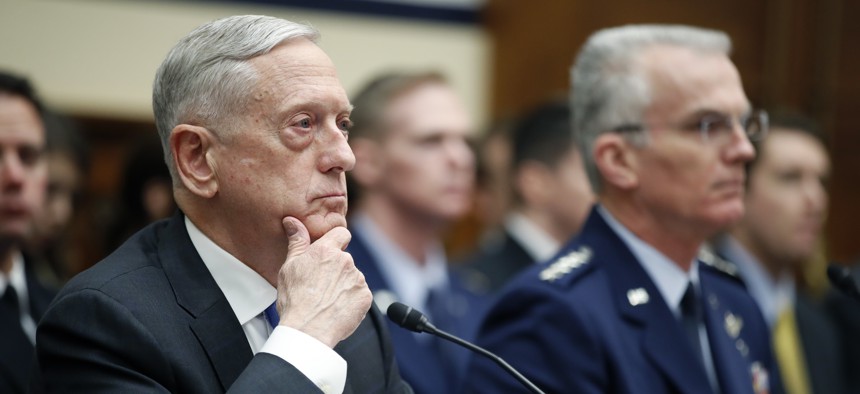
Defense Secretary Jim Mattis, left, and Vice Chairman of the Joint Chiefs General Paul J. Selva, testified today at a hearing of the House Armed Services Committee. Alex Brandon/AP
Mattis: New Sea-Launched Cruise Missile Is a Bargaining Chip
But don’t call the low-yield option a ‘tactical nuclear weapon’ — it’s still strategic, he says.
The U.S. plans to develop a new sea-launched cruise missile as a bargaining chip, Defense Secretary Jim Mattis said today.
Russia has developed and deployed nuclear weapons that violate the bilateral Intermediate Range Nuclear Forces Treaty, and the U.S. wants to nudge it back into compliance. But Moscow isn’t likely to “give up something to gain nothing from us in terms of reduction,” Mattis told lawmakers at the House Armed Services Committee.
Last week, Pentagon officials hinted at this rationale as they rolled out a new Nuclear Posture Review that calls for two new low-yield nuclear weapons and develop a potentially treaty-violating missile of its own. But Mattis was explicit today about the SLCM, saying “we have to give our negotiators something with which to negotiate” — and adding that there’s no guarantee the U.S. would give it up if Russia returned to compliance.
So it’s a bargaining chip? asked Rep. Rick Larsen, D-Wash.
“That’s correct,” Mattis responded.
Related: Pentagon Confirms It’s Developing Nuclear Cruise Missile to Counter a Similar Russian One
That’s not true of the broader pursuit of low-yield nuclear weapons, according to Mattis and Gen. Paul Selva, the vice chairman of the joint chiefs of staff who testified alongside him. Because, again, Russia: In addition to a ground-launched missile whose deployment violates the INF Treaty, Moscow has developed a suite of low-yield nukes of its own. Russia’s most recent military doctrine restricts its use of nuclear weapons to threats that endanger “the very existence of the state,” but analysts say that in practice, Moscow would consider using them to win a conventional war, or would “escalate to de-escalate.” The U.S. needs a way to discourage that, Mattis said.
“We don’t want someone else to miscalculate and think that because they are going to use a low-yield weapon, somehow we would confront what [former Secretary of State Henry] Kissinger calls ‘surrender or suicide,’” Mattis said. “We want to be certain they recognize we could respond in-kind, we don’t have to go with a high-yield weapon, thus the deterrent effort stays primary.”
That doesn’t mean the secretary thinks of them as tactical weapons — though the NPR uses the phrase at least twice.
“I don’t think there is any such thing as a ‘tactical nuclear weapon,’” he said. “Any nuclear weapon used any time is a strategic gamechanger.”
Arms control advocates have warned against the Pentagon’s decision to invest in the less powerful weapons, saying they lower the threshold for starting a nuclear war. Sixteen senators sent a letter to the Pentagon just before the NPR’s release expressing that concern, among others.
The U.S. currently has the B-61 gravity bomb, which provides a lower-yield option. But advances in air defenses means that potential adversaries have a better chance of stopping the plane carrying the bomb from getting to its target, Mattis acknowledged today.
“The bomber would have to penetrate” into an enemy’s airspace to deploy the B-61, he said. “But today air defense systems are all together different than 10 or 20 years ago.”
The U.S. retired its previous nuclear-tipped, sub-launched cruise missile — the nuclear Tomahawk land-attack cruise missile (TLAM/N) and its W80-0 warhead — sometime between 2010 and 2013.




